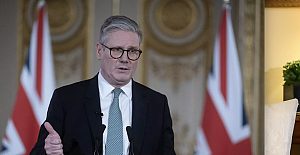India said that they lifted restriction on movement in most parts of Jammu and Kashmir and Ladakh.
“Over 93 percent of the state and 90 percent of the valley is now without any restrictions or prohibitory orders,” said the Jammu and Kashmir administration in a Wednesday's statement.
The majority of Jammu and Kashmir is free for any movement and accessible to outsiders, including journalists, except 12 police stations in Srinagar district and five elsewhere, the statement added.
“There has been a total of 192 incidents of law and order reported since Aug. 5,” it noted, with 165 of them were reported in Srinagar.
At least 100 people have been injured in the incidents, including more than 50 security personnel.
Although five deaths have been reported so far, the statement asserted that “only one of them has been attributed to the law and order disturbance.”
It also stressed that “not even a single live bullet has been fired to date.”
Jammu and Kashmir has been under a near-complete lockdown since Aug. 5, after India scrapped its special status as the government has blocked communication access and imposed restrictions to thwart any protests in the region.
With the new move, the Indian government further downgraded and divided the disputed region into two centrally controlled “union territories” or UT.
Several rights groups including Human Rights Watch and Amnesty International have repeatedly called on India to lift restrictions and release political detainees.
From 1954 until Aug. 5, 2019, Jammu and Kashmir enjoyed special status under the Indian constitution, which allowed it to enact its own laws. The provisions also protected the region's citizenship law, which barred outsiders from settling in and owning land in the territory.
India and Pakistan both hold Kashmir in parts and claim it in full. China also controls part of the contested region, but it is India and Pakistan who have fought two wars over Kashmir.


 Prime Minister Keir Starmer's 2025 Easter message
Prime Minister Keir Starmer's 2025 Easter message After Nesil Caliskan a by-election will be held in Jubilee ward in Enfield
After Nesil Caliskan a by-election will be held in Jubilee ward in Enfield Publishing the analysis, Labour’s Cllr Ergin Erbil said Everybody in Enfield deserves basic rights
Publishing the analysis, Labour’s Cllr Ergin Erbil said Everybody in Enfield deserves basic rights Gaza-Israel conflict Statement from Cllr Ergin Erbil, Leader of Enfield Council
Gaza-Israel conflict Statement from Cllr Ergin Erbil, Leader of Enfield Council The European Union called on Turkey to uphold democratic values
The European Union called on Turkey to uphold democratic values Turkish citizens in London said Rights, Law, Justice
Turkish citizens in London said Rights, Law, Justice The Council of Turkish Cypriot Associations Geneva response letter
The Council of Turkish Cypriot Associations Geneva response letter Sustainable Development and ESG, Will This Become the Course for Turkic World
Sustainable Development and ESG, Will This Become the Course for Turkic World The 'Prince of Paris' has impressed in his first EuroLeague season
The 'Prince of Paris' has impressed in his first EuroLeague season Saran Media And Euroleague Basketball Extend Media Rights Partnership for Four More Years
Saran Media And Euroleague Basketball Extend Media Rights Partnership for Four More Years Will Rangers be Jose Mourinho’s next victim?
Will Rangers be Jose Mourinho’s next victim? Jose Mourinho's Fenerbahce face Rangers on Thursday
Jose Mourinho's Fenerbahce face Rangers on Thursday Barclays has become the biggest UK lender so far to cut mortgage rates
Barclays has become the biggest UK lender so far to cut mortgage rates THE SPRING STATEMENT EXPLAINED, UK ECONOMIC OUTLOOK AND GROWTH FORECASTS
THE SPRING STATEMENT EXPLAINED, UK ECONOMIC OUTLOOK AND GROWTH FORECASTS Launch of Made in Enfield gift shop to celebrate local artists and designers
Launch of Made in Enfield gift shop to celebrate local artists and designers Trial used smart Wi-Fi sensors for live building occupancy data to optimise
Trial used smart Wi-Fi sensors for live building occupancy data to optimise

















